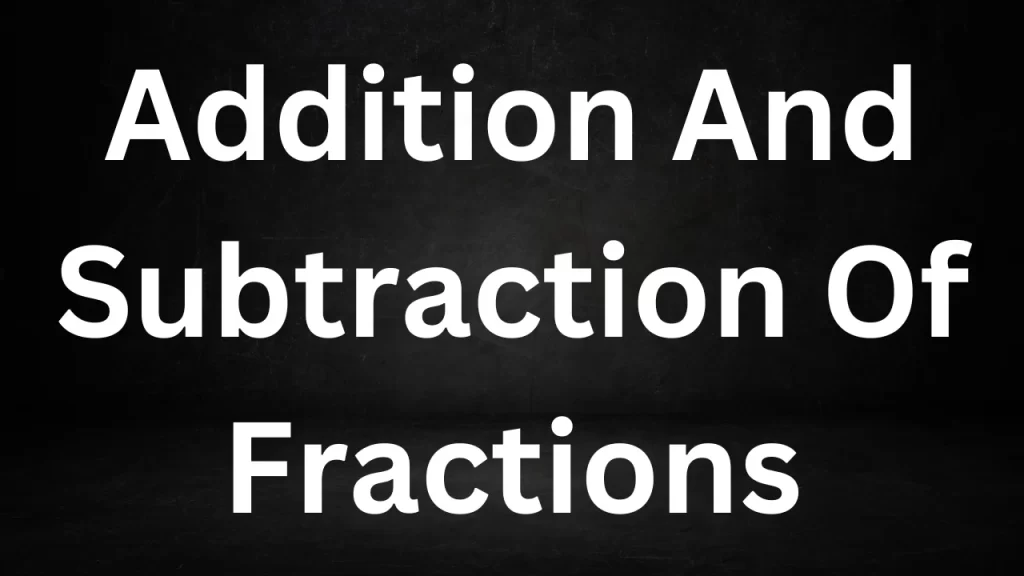Addition And Subtraction Of Fractions: Adding and subtracting fractions are fundamental operations in mathematics, particularly in the realm of fractions and rational numbers.
These operations are essential for solving various mathematical problems, and they are used in everyday life as well. Here’s a step-by-step guide on how to perform addition and subtraction of fractions:

Addition And Subtraction Of Fractions
Addition of Fractions:
To add fractions together, follow these steps:
- Ensure the denominators are the same: Fractions can only be added or subtracted when they have a common denominator. If the fractions you want to add have different denominators, find a common denominator by finding the least common multiple (LCM) of the denominators.
- Make the denominators the same: If the fractions already have a common denominator, you can skip this step. If not, you need to adjust one or both fractions so that they share the same denominator. To do this, multiply both the numerator and denominator of each fraction by the necessary factor to make their denominators equal.
- Add the numerators: Once the fractions have the same denominator, add the numerators together. The denominator remains the same.
- Simplify (if necessary): Reduce the resulting fraction to its simplest form by dividing both the numerator and denominator by their greatest common divisor (GCD).
Example: To add 1/4 and 3/8:
Step 1: Find a common denominator, which is 8. Step 2: Adjust the fractions: 1/4 becomes 2/8 (multiply numerator and denominator by 2). Step 3: Add the numerators: 2/8 + 3/8 = 5/8. Step 4: Simplify the fraction, if possible: 5/8 is already in its simplest form.
Subtraction of Fractions:
Subtracting fractions follows a similar process to addition:
- Ensure the denominators are the same: Just like with addition, you need a common denominator for subtraction. If the fractions have different denominators, find a common denominator by determining the LCM of the denominators.
- Make the denominators the same: If necessary, adjust the fractions so they share the same denominator. Multiply both the numerator and denominator of each fraction by the required factor.
- Subtract the numerators: Once the fractions have a common denominator, subtract the numerators while keeping the denominator the same.
- Simplify (if needed): Reduce the resulting fraction to its simplest form by dividing both the numerator and denominator by their GCD.
Example: To subtract 3/5 from 7/10:
Step 1: Find a common denominator, which is 10. Step 2: Adjust the fractions: 3/5 becomes 6/10 (multiply numerator and denominator by 2). Step 3: Subtract the numerators: 7/10 – 6/10 = 1/10. Step 4: Simplify the fraction, if possible: 1/10 is already in its simplest form.
By following these steps, you can successfully add and subtract fractions, whether they have common denominators or not. These skills are valuable for solving various mathematical problems, from everyday calculations to more advanced mathematical concepts.
Read More
- Difference Between Asteroid And Meteoroid
- Class 6 Maths Question Paper With Solutions NCERT PDF
- Sample Question Paper For Class 6 CBSE English Grammar
- NCERT Maths Book Class 6 Solutions PDF Free Download
Frequently Asked Question FAQs Addition And Subtraction Of Fractions
What are fractions?
Fractions represent parts of a whole or quantities that are not whole numbers. They are typically expressed as a numerator (the top number) over a denominator (the bottom number), such as 1/2 or 3/4.
Why do we need to add and subtract fractions?
Adding and subtracting fractions are essential for various real-world applications, such as cooking, measurements, and financial calculations. They are also fundamental in mathematics, helping to solve equations and understand the concept of rational numbers.
How do I know when to add or subtract fractions in a problem?
The decision to add or subtract fractions depends on the context of the problem. If you are combining quantities or parts, you typically use addition. If you are finding the difference between quantities or removing parts, you use subtraction.
What is a common denominator?
A common denominator is a shared denominator between two or more fractions. When adding or subtracting fractions, having a common denominator is necessary for performing the operation.
How do I find a common denominator for fractions with different denominators?
To find a common denominator, determine the least common multiple (LCM) of the denominators. Then, use the LCM as the common denominator for the fractions.
